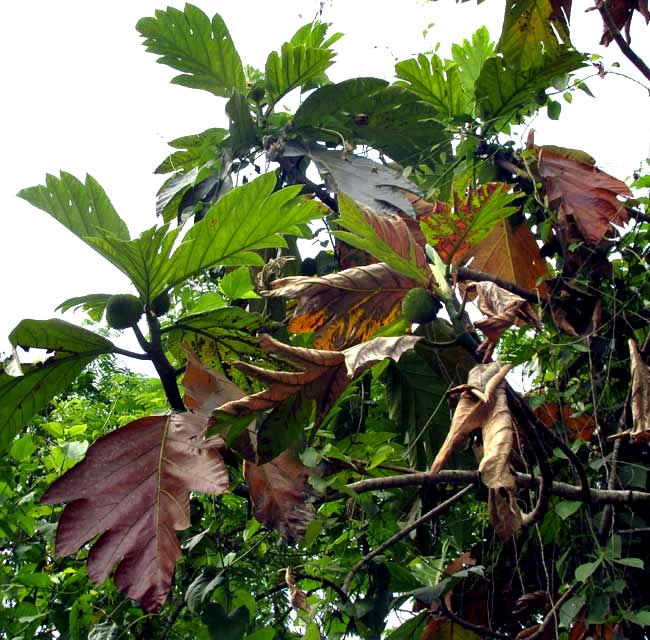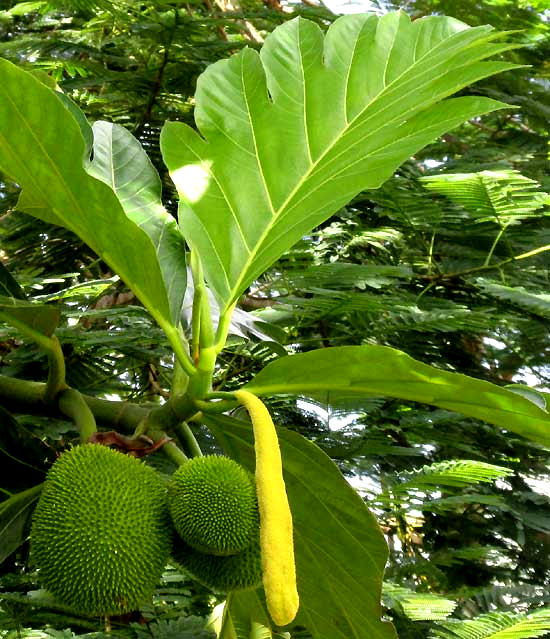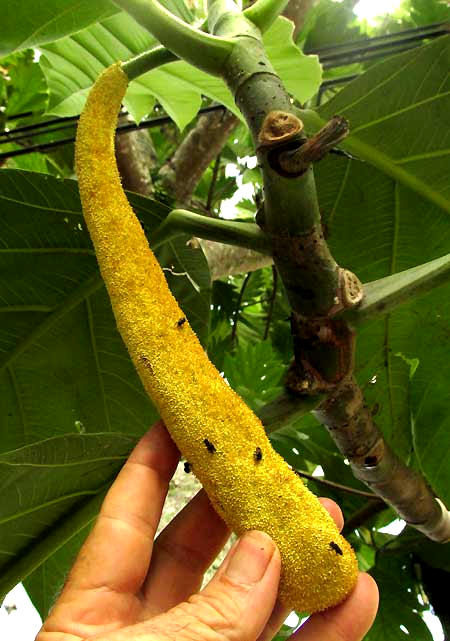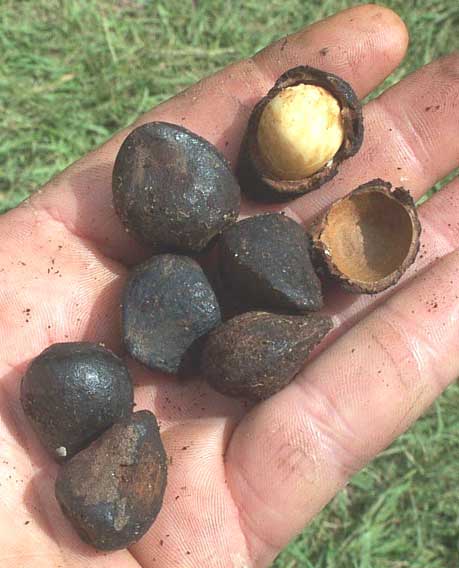Excerpts from Jim Conrad's
Naturalist Newsletter
from the May 1, 2016 Newsletter with notes from a visit to Lacanja Chansayab in the Lacandon Reserve; elevation 200m (650ft), N16.604°, W90.917°; Chiapas, MÉXICO
BREADNUT
In Chiapas's Lacandon Reserve, some Lacandon homes in the village of Lacanja Chansayab have Breadnut trees standing next to them, the trees easily recognizable because of their thick, leathery, deeply incised leaves growing two feet long and longer, as shown below:

Late April is the heart of the dry season in Chiapas, which explains why in the picture the tree's lower leaves are turning brown and falling off. This vulnerability to drought also explains why the tree is seen only rarely in the much drier Yucatan. Toward branch tips in the above picture you can make out some very immature breadnut fruits, a close-up of a couple being shown below:

Breadnut fruits are spiny-looking because they're "multiple fruits," meaning that many "simple" flowers have grown together as their ovaries matured and enlarged, forming a single thing that looks like one prickly fruit. Each of the Breadnut "fruit's" many green prickles represents a single "real" Breadnut flower, of which hundreds constitute a single "multiple fruit."
Breadnut trees, ARTOCARPUS CAMANSI, are native to New Guinea and thereabouts, from which people distributed them throughout the Pacific area so that now they are planted in the humid tropics worldwide. Not only are its big, starchy fruits good to eat when roasted, baked, fried or boiled, but also its wood is strong enough for constructing buildings, and the "nuts," or seeds, are eaten roasted and in other ways {See next entry}.
Jackfruit trees, Artocarpus heterophyllus, produce somewhat similar fruits but their leaves are not deeply lobed. Breadfruit trees, Artocarpus altilis, are very similar, but the fruits are smaller and aren't as prickly looking. Some experts believe that Breadfruit may be derived from Breadnut trees.
Also, this Breadnut tree shouldn't be confused with another Breadnut, sometimes called Ramón, Bosimum alicastrum, in the same family, and which are native and common in the drier Yucatan. That Breadnut is profiled at www.backyardnature.net/mexnat/ramon.htm
This is a good example of the fact that if you want to get all these names straight you just have to use the technical binomial names.
from the February 15, 2019 Newsletter with notes from a camping trip into Chiapas, the southernmost state of MÉXICO
BREADNUT TREE'S MALE FLOWERS
Breadnut trees bear unisexual flowers. Their large, spherical, spiky fruits are technically called "syncarps," because they're composed of the matured pistils of 1500-2000 female flowers. Each spine on a fruit represents a single female flower, so what we think of as the big Breadnut fruit is actually a collection of many hundreds of fruits.
Last October during my camping trip in Chiapas, on the entry road to Palenque National Park, a Breadnut tree turned up bearing not only spiky fruits but also a long, yellow item dangling from a branch's tip, shown below:

The yellow thing is about 25cm long (10inches). Up close it became apparent what it was:

It's a flowering head of what must be tens of thousands of closely packed male flowers, each flower bearing just one stamen. In the picture small, native bees are collecting pollen from the masses of anthers.
One wonders why the male flowering head is so large and conspicuous. Is so much pollen really needed, and must it be presented in such a spectacular manner? On the Internet there's an interesting paper entitled "A Flower in Fruit’s Clothing that offers some insight. It describes how a certain kind of gall midge, an insect that damages fruits by laying eggs in them, is attracted to such conspicuous heads of male flowers -- which appear before the fruits ripen -- thus being deflected from depositing eggs in the fruits.
from the November 19, 2007 Newsletter written at Yerba Buena and issued from a ciber in Pueblo Nuevo Solistahuacan, Chiapas, MÉXICO
CLEAR PLASTIC BAGS OF CACATÉ
On buses carrying you upslope from Villahermosa to here you pass through many colorful little villages as the road zigzags up and up. When I arrived here in October, at about mid slope, vendors started appearing hawking small, clear-plastic bags of blackish, more or less spherical, mothball-size things. Everyone was calling out, almost like roosters crowing, "Cacatés... Cacatés... "
When the bus driver stopped for a rest he and several passengers bought some bags, then stood around cracking the black things between their teeth and agreeing how good their cacatés tasted. At the next stop I bought a bag myself, found the cacatés' shells harder than I wanted to subject my molars to, and the white, oily flesh inside somewhat bitter and salty. You can see several cacatés in the palm of my hand below:

Since local people seemed to love cacatés I brought Inés a bag as a little gift. Turns out she keeps a large, plastic garbage bag of them for serving to guests. Also, in Pueblo Nuevo's open-air market there's always one to several people selling clear-plastic bags filled with cacatés. They're almost like bags of popcorn at the movies: People act surprised if you don't buy one from them.
At first I didn't have the slightest idea what cacatés were, and then I thought that they were specially prepared Ramón, BROSIMUM ALICASTRUM, a member of the Fig Family. But after I wrote about them in the Newsletter, Erika Vohman, Executive Director of the Maya Nut Institute, wrote saying that they were the seeds of ARTOCARPUS CAMANSI, very closely related to the Breadfruit tree, and in English usually called Breadnut trees, despite that name also being used for the Ramón.
Inés tells me that the black, hard-shelled fruits sold here are brought up from the lowlands and prepared in three ways. First, the fruits can be dried in the sun, then stored for a long time and eaten with no further preparation. Second, the black fruits being sold have been boiled in salt water, then dried. Third, the boiled, dried fruits can be opened, then the white flesh canned in water.
This is one of the most underappreciated, underutilized plants I know of. The seeds are low in fat but high in protein and taste like chestnuts. They can be roasted like our cacatés, canned, or processed into paste, butter, flour or oil. Oil extracted from the seeds is rich in unsaturated fatty acid and is a good source of edible fat for human consumption.